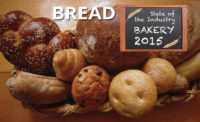Despite the enormous variety of snacks available at retail, chips continue to be the snack of choice for consumers. Potato chips saw growth across the board, with shoppers intrigued by classic products, along with formats that include multigrain chips and fruit chips.
Overview | Chips | Puffed/Extruded Snacks | Popcorn | Snack Mixes & Nuts | Tortilla Chips | Pretzels | Frozen Snacks | Crackers
The salty snacks category, as tracked by IRI, Chicago, is massive, responsible for $21.3 billion in dollar sales for the 52 weeks ending May 17, 2015. Potato chips fall within it, and sales reached $7.23 billion—accounting for 34 percent of the category’s sales—with an increase of 4.27 percent in dollar sales for the year. Tortilla chips came in a distant second, with 23 percent of sales, followed by “other salted snacks” with 18 percent of the category total. Cheese snacks, corn snacks, popcorn and pretzels each accounted for less than 9 percent in sales for the category.
Market data
Consumers love their chips. And thanks to increased snacking, the potato chip category is more relevant than ever. All top five chip manufacturers and brands finished the 52 weeks ending May 17, 2015, up in dollar sales compared to the same period a year ago, per IRI.
Frito-Lay, the category leader, saw sales increase 4.1 percent, to $4.36 billion. Its flagship Lay’s brand accounted for just under 30 percent of potato chip sales for the year, taking in $2.16 billion in sales. Its Ruffles brand sits at No. 2 on the list of the top five potato chip brands at $731.37 million, up 8.05 percent in dollar sales. Lay’s Wavy took in $575.12 million, up 6.59 percent.
Elsewhere in the top five, Kellogg Co. was up 0.92 percent, to $763.41 million, with its Pringles brand taking in $676.36 million, up 2.19 percent in dollar sales. Private label takes the No. 3 spot, with $489.84 in sales, up 4.25 percent. Utz Quality Foods climbed 4.23 percent in dollar sales to $273.38 million.
The big category breakout was Cape Cod chips, a company that’s a subsidiary of Snyder’s-Lance. Although the smallest of the national brands at No. 5 on the list of top chip companies, Cape Cod grew a notable 22.5 percent for the 52-week period.
Fruit has grown into a viable—but still minor—chip segment, with apple chips, part of the miscellaneous snacks category, showing strength for the period, growing 49.33 percent in dollar sales, to $9.44 million in sales for the 52-week period.
Looking back
Although Americans have claimed a desire for better-for-you snack options, how they define those options—and how much they’re willing to sacrifice in terms of expected texture and flavor—is a constantly changing landscape. Shifting diet philosophies also often influence what consumers look for in snacks.
Interest in gluten-free—above and beyond those clinically diagnosed with celiac disease or suffering from gluten intolerance—has continued to grow over the past several years. While some snacks largely dependent on wheat have seen some reduced sales activity, potato and fruit chips, which can easily claim gluten-free status, have maintained and built widespread appeal. Multigrain chips also often fit into gluten-free formulation rubrics as their texture can result from a number of different grain ingredients, as well as nutritional inclusions like seeds.
Ten years ago, when brands focused on delivering better-for-you options, they talked about what they were taking out of their products—like fat, cholesterol and sodium. Consumers, meanwhile, started becoming more concerned about what was in their foods, rather than what wasn’t. This led to increased interest in clean label, with friendly sounding ingredients and ingredient sources. Now, organic and non-GMO ingredients are almost a point of entry to reach some segments of the population.
“Nutrition is still relevant, but consumers are now looking for quality ingredients and minimally processed foods,” says Rick Suchenski, senior vice president, sales and marketing, Good Health Snacks, a division of Utz Quality Foods, Hanover, PA. He suggests that better-for-you chips are seeing double-digit growth; overall, IRI data shows the salty snacks category is only up 4.55 percent in dollar sales.
“Overall, we have noticed a general trend towards healthier snacking,” says Tim Reardon, group solutions manager, processing, tna, Portland, OR. “Consumers have become increasingly concerned about the amount of fat, sugar and salt they consume. As a result, many snack manufacturers are looking for technologies to help them produce healthier chips without losing the crunchy texture and great taste that consumers expect. At the same time, there has also been a move toward developing new healthier alternatives to the regular potato chip. A lot of snack manufacturers are either experimenting with new vegetable or fruit-based snacks or have already brought these new varieties to the market with great success.”
In line with the demand for healthier snacks, acrylamide levels can factor into consumer snack decisions, says Reardon. “As such, snack processors are continually looking for ways to cost-effectively reduce the contributing factors of its generation in fried foods—in particular, technologies to control the temperature of the frying process are of universal interest.”
Reardon notes that high-performance frying technology can help chip manufacturers improve chip quality and better-for-you status. “One of the latest innovations in this area is a two-stage frying process, in which after about 80 percent of the frying time in an atmospheric fryer, products are transferred to a vacuum fryer to finish the frying process at lower temperatures and in milder conditions,” he says. “These low temperatures at the end of the process preserve the natural colors and flavors of the product, while at the same time enabling the reduction of acrylamide levels to less than 500 micrograms.”
Reardon notes that the technology is also ideal for fruit and vegetables that are high in natural sugars, such as parsnips, beets, carrots, apples, kiwi and mango, opening up new vegetable and fruit chip opportunities.
To meet consumers’ increased demand for quality ingredients, manufacturers must re-examine each product component, including the oils they’ve traditionally used to fry their chips, opting for avocado, olive or coconut oil. Boulder Brands released its Boulder Canyon Avocado Oil Canyon Cut and Olive Oil Canyon Cut potato chips in late 2013. Then this year, the brand launched its Coconut Oil Kettle Cooked Potato Chips. The company notes the monounsaturated fat content of these oils in marketing materials.
Good Health Snacks has released Avocado Oil Kettle Chips (in Sea Salt and Lime Ranch flavors) and Olive Oil Kettle Chips (in Sea Salt and Cracked Pepper flavors). However, changing cooking oil is not a simple process for manufacturers. Different oils will have distinct fry temperatures and flash points, and may be less forgiving to temperature fluctuations than traditional cottonseed oil. “Producing chips with avocado oil was challenging from both a technology and a pricing perspective,” says Suchenski. “We had to do our homework to make sure we communicated a compelling point of difference to our consumers.”
In addition to ingredients, consumers have been paying closer attention to the various cooking process chip manufacturers use to make their products. Kettle chips are typically cooked one batch at a time and, therefore, spend less time in the oil. Traditional potato chips generally run in a continuous frying process. Kettle cooking is also seen as more artisanal. These factors have contributed to rising sales for kettle chips, as seen in the strong performance of Lay’s Kettle Cooked chips, up 10.70 percent in dollar sales to $368.12 million, per IRI. Snyder’s-Lance Cape Cod potato chips were up 22.52 percent to $225.33 million for the period, and Kettle Food Inc.’s Kettle Brand potato chips were up 11.11 percent to $180.51 million.
Some salty snack manufacturers are looking beyond the potato to make their products more nutritious and stand out in the very crowded chip field. To that end, some brands are incorporating legumes into their snacks when possible. Food Should Taste Good, a General Mills brand, launched two bean-containing chip varieties—Pinto Bean Multigrain and Black Bean Multigrain. The fiber-rich chips are made with non-GMO ingredients, including flax, sesame, sunflower seeds and quinoa.
Flexibility to meet consumer demand is also paramount to chip success these days. This can come via flavor profiles, as well as chip style and composition. Don Giles, director of sales, snack processing systems, Heat and Control Inc., Hayward, CA, notes an emerging trend of chips produced from ingredients like legume flour to fit into healthier food trends and new markets.
Two recent fryer developments, notes Giles, allow processors to produce many different types of chips using the same equipment, including a system with three or more small fryer systems, each with its own heat exchanger, filter and oil-circulation system. “In addition to almost infinite adjustability of oil temperature profiles, product agitation and dwell time is individually adjustable in each fryer section,” he says. This allows the equipment to fry everything from kettle-style chips to traditional continuous-fried potato chips with no slice washing. “It can also fry chips from grain, sweet potato, taro root and other ingredients,” Giles adds.
Another fryer handles chips made from potatoes, apples, yams and high-sugar products with no browning, notes Giles. “It operates at 10 percent or less of normal atmospheric pressure, so product moisture boils off at a lower temperature. This also helps control acrylamide, because the frying oil temperature can be kept below the 248°F point at which acrylamide forms.”
Looking forward
Regardless of how better-for-you a chip is, consumers still want it to taste great. As the result, the chip category has seen a proliferation of flavor explorations, growing more artisanal, bold and edgy, and sometimes borrowing from other categories. Limited-edition flavors also continue to add excitement to the chip category, building brand awareness.
Giles notes the increased variety in seasonings to differentiate chips and appeal to new markets. Available seasoning systems let processors to apply their entire range of flavors at the same time—without cross-contamination. “This saves down time associated with seasoning changeovers, speeds fulfillment of orders for a greater variety of seasoned chips, and reduces warehousing time,” he says. The system proportionally distributes chips to multiple seasoning applicators that directly feed weighers and bag-makers. “Each applicator can apply a different flavor, eliminating the wait before seasonings can be run.”
Cape Cod has launched flavors like Sea Salt & Cracked Pepper, Sweet & Spicy Jalapeño and Sweet Mesquite Barbeque. Last year, Lay’s launched Wasabi Ginger, named the winner of its 2014 “Do Us a Flavor” contest, which invites consumers to submit their ideas for the next new potato chip flavor (other finalists included Cappuccino, Cheddar Bacon Mac & Chesse and Mango Salsa). Limited-edition flavors launched by Cape Cod chips include “Limited Batch” Sweet Red Chili and Chipotle Barbeque.
“Both kids and adults are watching the Food Network and various cooking shows,” says Hansley Thomas, community marketing specialist, Herr Foods, Nottingham, PA. “Their awareness of different flavor profiles is broader than ever. People are more open to these types of flavors.”
One of the more-interesting developments in the flavor space has been the introduction of “meaty” flavor profiles. Herr’s has launched chips flavors like Kansas City Prime Steak and Baby Back Ribs. Thomas notes that there’s a “hint” of a meaty flavor in these items. “We’re borrowing a bit from the meals category,” she adds.
If there’s a brand known for interesting, bold flavors, it is Zapp’s, an Utz Quality Foods brand. The company’s original “New Orleans Kettle Style” potato chip flavor was Spicy Cajun Crawtators. More recently, the brand has come out with extreme flavors like Hotter ‘N Hot Jalapeño and Voodoo. “Good flavor ideas come from anywhere—customers, sales team, distributors and suppliers,” says Richard Gaudry, vice president of sales, Zapp’s, Gramercy, LA. “We listen to all this input, and we build on trends.”
Overview | Chips | Puffed/Extruded Snacks | Popcorn | Snack Mixes & Nuts | Tortilla Chips | Pretzels | Frozen Snacks | Crackers












